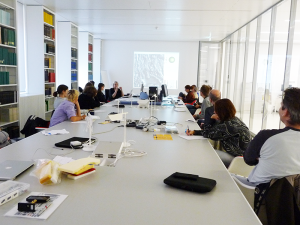The Present uncovers the Past: Reflectance Transformation Imaging
RTI trainings in Topoi equip researchers with a state of the art documentation and analysis tool for the documentation and research of cultural heritage
RTI images do look like common digital pictures – but they allow the viewer to click on the picture and interactively move the light source: All RTI images are shot from a single fixed camera position. Only the light source is repositioned at a constant radius from the object: It enables the interactive re-lighting of the subject from any direction. The final file determines all possible light positions within the virtual hemisphere, in addition to those in images. The final image initially looks like a flat photograph, but it actually is the documentation of the subject’s surface interaction under the changing light positions.
The changing interplay of light and shadow in the digital image discloses fine details of the subject’s 3D surface form, although it’s resembled from single 2D photographic images. RTI also permits the mathematical enhancement of the subject’s surface shape and color attributes. The enhancement function reveals surface information that is not disclosed under direct examination of the physical object.
RTI TRAININGs in TOPOI

RTI Workshop presented by Carla Schroer, Mark Mudge and Marlin Lum of Cultural Heritage Imaging (CHI) | © Kathryn E. Piquette
In October 2012, Topoi successfully ran a series of events on Reflectance Transformation Imaging (RTI) organised by Cornelia Kleinitz and Kathryn E. Piquette in collaboration with the Staatliche Museen zu Berlin. Topoi’s aim of introducing this innovative computational photographic technique was to equip researchers with a state of the art documentation and analysis tool for cultural heritage whether in museum or field contexts.
The workshop and training was presented by Carla Schroer, Mark Mudge and Marlin Lum of Cultural Heritage Imaging (CHI), a nonprofit organisation based in San Francisco, California and dedicated to advancing digital capture and documentation technologies. Their engaging and informative half-day workshop of lectures and technical demonstrations was held in the Archäologisches Zentrum of the Staatliche Museen zu Berlin and attended by over 100 staff, affiliated researchers, students and members of the public.
The workshop was followed by 4-day training for 15 Topoi fellows and affiliates, who included members of the German Archaeological Institute (DAI), the Berlin Brandenburg Academy of Sciences (BBAW), Humboldt-Universität zu Berlin as well as Freie Universität Berlin. Trainees learned how to set up RTI equipment, perform capture sequences on artefact surfaces of different shapes, sizes and in various locations, and to process the resultant image data in order to create super high-resolution digital images of material surfaces that can be relit from any direction.
Thanks to this training, several Topoi-associated projects are now and imminently applying RTI to a range of cultural heritage research. These include research on graffiti and rock art, bead production, scribal and artistic tool and techniques, impressed sealings, pottery production, stone tools, ivory artefacts, engraved gems and paper squeezes. An ongoing goal of Topoi in funding these events is to grow the RTI community among its members, affiliates and beyond.
RELATED LINKS
Event: Reflectance Transformation Imaging (RTI) for cultural heritage documentation
Feature: Scribal and Artistic Spaces
Read more articles in TOPOI FEATURE

